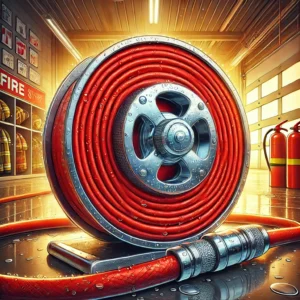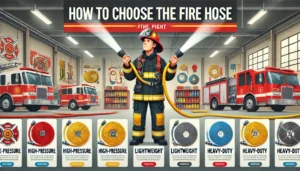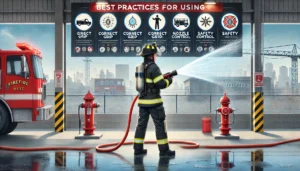The Ultimate Overview of Fire Hoses
Fire protection is an important part of public and personal security, and a fire hose does a vital job of protecting lifestyles and homes. Whether it’s snuffing out a surging fire in a structure or protecting commercial amenities, fire hoses are vital devices for firemen as well as security crews. “How well do you understand the critical role of fire hoses in fire safety?” This thorough resource is going to deal with every little thing you require to understand, from their styles and components to appropriate maintenance and advancements, making the specialized parts friendly and understandable.
What is a Fire Hose?

A fire hose is an extremely tough, adaptable pipe that supplies pressurized water (or even other fire-suppressing agents) onto a fire. Its main reason? Battle fires swiftly and properly while safeguarding firemen’s and residential property. Fire-hoses are more than tools—they are lifelines in critical emergencies, trusted by first responders worldwide.”
Firefighters and safety and security teams hold different kinds of fire hoses, each fulfilling distinct functions. From versatile supply hoses to high-pressure strike hoses, their varying arrangements allow them to conform to assorted situations, like structure fires, car fires, and outdoor fires.
Why It is Important?
Fire-hoses guarantee successful water distribution over huge locations, creating all of the important tools for subduing fires early and protecting communities.
Types of Fire Hoses: A Complete Guide.

Various fire emergencies ask for certain hose kinds, as well as knowing these distinctions may help make all the variations:
1. Attack Hose
Created to deliver water directly onto the fire, assault hoses are lightweight but long-lasting. They run under high pressure and are usually made use of by firefighters for active fire reductions.
2. Supply Hose
Also referred to as a source pipe, this hose connects a hydrant or even water resource to the fire engine. With a sizable diameter, it supplies a steady flow of water to attack hoses.
3. Forestry Hose
Forestry hoses are lightweight and made for handling fires in sturdy atmospheres, like woods or national forests.
4. Booster Hose
These smaller, rubber-coated hoses are commonly mounted on reels atop fire trucks. They are best for extinguishing tiny fires or even auto collisions.
5. Industrial Fire Hose
Made use of in centers like oil refineries as well as chemical vegetations, industrial hoses are concentrated to manage large fire feedback and also avoid harsh temps.
Each sort of fire hose is equipped with specific features to satisfy its job. Whether you’re a fireman, commercial security policeman, or facility supervisor, selecting the ideal hose will certainly find out the velocity as well as the excellence of fire reduction attempts.
Components of a Fire Hose

Recognizing exactly how a fire hose is built offers useful ideas right into its durability as well as functionality.
1. Outer Jacket
Produced from man-made threads like polyester, the outer jacket guards the hose coating coming from scrapes and chemicals, as well as ecological visibility.
2. Inner Lining
Typically crafted from rubber or elastomers, this lining makes sure a watertight flow while enduring extreme requirements and also warm. “According to NFPA guidelines, fire hoses must withstand up to 300 PSI to ensure they meet rigorous safety standards during emergency use.”
3. Hose Couplings
Coupling connects lengths of hose and connects them to faucets or water resources. Created from durable components like aluminum or brass, they are crucial for flexibility on the ground.
4. Nozzles
Hose nozzles play a key role in directing and controlling water flow. Adjustable designs offer spray and stream options depending on the fire scenario.
By combining heavy-duty materials and exact engineering, modern-day fire hoses are created to endure even the most difficult situations, along with stability and simplicity.
How To Choose The Right Fire Hose

Picking the appropriate fire-hose dimension is vital for maximizing efficiency. Right here’s what you need to look at:
Hose Diameter:
- Larger hoses are much better for source lines, while much smaller hoses work well for attack lines that require the ability to move.
Hose Length:
- The span should match the functional distance– longer hoses are excellent for getting to remote fires.
Tension Rating:
- This indicates the maximum stress the hose can handle, which varies depending on the fire style.
Building Material:
- Look for hoses along with man-made coats or rubber cellular linings for sturdiness in difficult settings.
Conformity Standards:
- Always check that the fire hose satisfies local fire safety requirements and accreditations.
- Proper sizing not only influences the firefighting rate but also ensures firefighters remain secure and energetic under the gun.
“Hose pressure rating is a critical factor. According to NFPA guidelines, fire-hoses must withstand up to 300 PSI to meet industry safety standards.”
Maintenance tips and Inspection tips:
A well-maintained fire hose lasts longer as well as executes efficiently throughout emergencies. Listed below is an easy guide to ensure its own long life and also integrity:
1. Routine Inspections
- Check for obvious damage, hairstyles, or cuts on the external jacket.
- Inspect hose couplings for decay or damage.
- Exam coverings to guarantee watertight seals.
2. Regular Cleaning
- Tidy hoses extensively after direct exposure to dirt, chemicals, or even deep sea.
- Make use of moderate cleaning agents to avoid harming the inner lining.
3. Effective Storage
- Outlet hoses in awesome, dry areas to avoid mold and mold.
- Stay clear of prolonged visibility to drive sunshine, which can damage man-made fibers over time.
4. Timely Repairs
- Substitute destroyed coupling or sections right away.
- Use appropriate repair work packages while preserving compliance with field specifications.
- Regular checks lengthen the life span of any fire-hose while guaranteeing it continues to be prepared for action when it matters very most.
Read About: hose vs hose pipe
Innovations in Fire Hose Technology
Improvements in product science as well as production have renewed the fire-hose to unmatched amounts of toughness and performance.
Trick Innovations:
- Light In Weight Synthetic Materials: Today’s hoses are dramatically lighter, boosting the ability to move for firefighters.
- Heat-Resistant Linings: Improved internal linings stand up to higher temperatures in the course of severe firefighting states.
- Smart Hoses: Some fire-hoses currently include inserted sensing units to measure water stress, temp, and also flow fees in real-time.
- Eco-Friendly Materials: Many manufacturers right now create hoses utilizing sustainable and also recyclable products.
These advances produce contemporary fire hoses even more dependable, flexible, and also environmentally conscious.
Best Practices for Using a Fire Hose

Effective and risk-free operations with a fire-hose demand faithfulness to key finest methods:
- Correct Training: Ensure all users are trained in setting up, running, as well as withdrawing hoses.
- Water Pressure Control: Avoid too much pressure that might damage the hose or its couplings.
- Wear Protective Gear: Always wear suitable fire-resistant suits, gloves, and footwear.
- Get Connections: Double-check couplings and mist nozzles for protected add-ons before the function.
- Correspond Clearly: Maintain crystal clear interaction between all employees during implementation.
Following these guidelines decreases threats and also makes certain maximum efficiency in the course of fire suppression.
Where to Buy Fire Hoses:
When it involves acquiring top-notch fire-hoses, choosing reputable vendors is non-negotiable.
Reputed suppliers give certified products created with meticulous safety requirements.
Top Recommendations:
- Local Area Fire Equipment Stores: Tailored solutions along with in-person appointments. Online Retailers: Websites like Amazon or concentrated safety and security systems supply various choices.
- Straight coming from Manufacturers: Brands like Angus Fire, Dixon, and Key Fire Hose are known for their premium-quality items.
Investigate and also review items, as well as regularly read through client assessments before purchasing selection.
Conclusion:
A fire-hose is more than just a conventional firefighting device; it’s an essential property that spares lives, guards property, and also ensures safety and security. Whether you’re working in emergency reaction, commercial security, or even facility management, recognizing its styles, products, as well as appropriate care is crucial for superior efficiency.
By buying a top-quality fire hose and keeping improved on maintenance, you’re far better geared up to deal with any obstacle. For those finding premier hoses, look into trusted vendors to locate reliable, professional items.
Fire protection goes beyond extinguishing flames—it’s about preparation, prevention, and safeguarding communities. By choosing and maintaining high-quality fire hoses, you can ensure safety and efficiency when it matters most. With a well-kept and attentively picked fire hose, you’ll constantly be one step in advance in making certain safer communities and work environments.